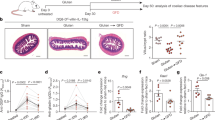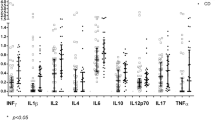Abstract
The IL-33/ST2 axis has been implicated in the pathogenesis of several tissue-specific autoimmune diseases. Celiac disease (CD) is the only autoimmune disease in which both the major genetic factors (HLA-DQ2/DQ8) and etiologic ones (dietary gluten) for susceptibility are known. We have measured serum levels and determined intestinal tissue expression of IL-33 and its receptor soluble ST2 in patients with CD to investigate their association with disease activity. Serum and tissue levels of both IL-33 and sST2 were significantly higher in patients with CD compared with those in control patients without CD. We show that toxic peptides extracted from barley and wheat gliadin significantly stimulate the production of IL-33 and ST2 in cultured peripheral blood mononuclear cell from celiac patients, strongly implicating the IL-33/ST2 axis in the pathogenesis of CD. The higher levels of IL-33 and its receptor ST2 in tissue and serum reflect an active inflammatory state and may represent a potential biomarker for disease activity. A better understanding of IL-33/ST2 release, mode of action, and regulation will be crucial to develop therapeutics that target the IL-33/ST2 pathway to treat CD.
This is a preview of subscription content, access via your institution
Access options
Subscribe to this journal
Receive 12 digital issues and online access to articles
$119.00 per year
only $9.92 per issue
Buy this article
- Purchase on Springer Link
- Instant access to full article PDF
Prices may be subject to local taxes which are calculated during checkout




Similar content being viewed by others
References
Sollid LM . Celiac disease: dissecting a complex inflammatory disorder. Nat Rev Immunol 2000; 2: 647–655.
Alaedini A, Green PH . Narrative review: celiac disease: understanding a complex autoimmune disorder. Ann Intern Med 2005; 142: 289–298.
Torres MI, López-Casado MA, Luque J, Peña J, Ríos A . New advances in celiac disease: serum and intestinal expression of HLA-G. Int Immunol 2006; 18: 713–718.
Fasano A . Clinical presentation of celiac disease in the pediatric population. Gastroenterology 2005; 128: S68–S73.
Kim CY, Quarsten H, Bergseng E, Khosla C, Sollid LM . Structural basis for HLA-DQ2-mediated presentation of gluten epitopes in celiac disease. Proc Natl Acad Sci USA 2004; 101: 4175–4179.
Torres MI, López Casado MA, Ríos A . New aspects in celiac disease. World J Gastroenterol 2007; 13: 1156–1161.
Sollid LM, Markussen G, Ek J, Gjerde H, Vartdal F, Thorsby E . Evidence for a primary association of celiac disease to a particular HLA-DQ alpha/beta heterodimer. J Exp Med 1989; 169: 345–350.
Anderson RP, Degano P, Godkin AJ . In vivo antigen challenge in celiac disease identifies a single transglutaminase-modified peptide as the dominant A-gliadin T-cell epitope. Nat Med 2000; 6: 337–342.
Shan L, Molberg Ø, Parrot I, Hausch F, Filiz F, Gray GM et al. Structural basis for gluten intolerance in celiac sprue. Science 2002; 297: 2275–2279.
Comino I, Real A, Gil-Humanes J, Pistón F, de Lorenzo L, Moreno Mde L et al. Significant differences in celiac immunotoxicity of barley varieties. Mol Nutr Food Res 2012; 56: 1697–1707.
Comino I, Real A, de Lorenzo L, Cornell H, López-Casado MÁ, Barro F et al. Diversity in oat potential immunogenicity: basis for the selection of oat varieties with no toxicity in celiac disease. Gut 2011; 60: 915–922.
Real A, Comino I, de Lorenzo L, Merchán F, Gil-Humanes J, Giménez MJ et al. Molecular and immunological characterization of gluten proteins isolated from oat cultivars that differ in toxicity for celiac disease. PLoS One 2012; 7: e48365. doi: 10.1371/journal.pone.0048365.
Arend WP, Palmer G, Gabay C . IL-1, IL-18, and IL-33 families of cytokines. Immunol Rev 2008; 223: 20–38.
Sims JE, Smith DE . The IL-1 family: regulators of immunity. Nat Rev Immunol 2010; 10: 89–102.
Liew FY, Pitman NI, McInnes IB . Disease-associated functions of IL-33: the new kid in the IL-1 family. Nat Rev Immunol 2010; 10: 103–110.
Murphy GE, Xu D, Liew FY, McInnes IB . Role of interleukin 33 in human immunopathology. Ann Rheum Dis 2010; 69: i43–i47.
Carriere V, Roussel L, Ortega N, Lacorre DA, Americh L, Aguilar L et al. IL-33, the IL-1-like cytokine ligand for ST2 receptor, is a chromatin-associated nuclear factor in vivo. Proc Natl Acad Sci USA 2007; 104: 282–287.
Schmitz J, Owyang A, Oldham E, Song Y, Murphy E, McClanahan TK et al. IL-33, an interleukin-1-like cytokine that signals via the IL-1 receptor-related protein ST2 and induces T helper type 2-associated cytokines. Immunity 2005; 23: 479–490.
Haraldsen G, Balogh J, Pollheimer J, Sponheim J, Kchler AM . Interleukin-33 – cytokine of dual function or novel alarmin? Trends Immunol 2009; 30: 227–233.
Li H, Tago K, Io K, Kuroiwa K, Arai T, Iwahana H et al. The cloning and nucleotide sequence of human ST2L cDNA. Genomics 2000; 67: 284–290.
Palmer G, Lipsky BP, Smithgall MD, Meininger D, Siu S, Talabot-Ayer D et al. The IL-1 receptor accessory protein (AcP) is required for IL-33 signaling and soluble AcP enhances the ability of soluble ST2 to inhibit IL-33. Cytokine 2008; 42: 358–364.
Oshikawa K, Kuroiwa K, Tago K, Iwahana H, Yanagisawa K, Ohno S et al. Elevated soluble ST2 protein levels in sera of patients with asthma with an acute exacerbation. Am J Respir Crit Care Med 2001; 164: 277–281.
Kuroiwa K, Arai T, Okazaki H, Minota S, Tominaga S . Identification of human ST2 protein in the sera of patients with autoimmune diseases. Biochem Biophys Res Comm 2001; 284: 1104–1108.
Talabot-Ayer D, McKee T, Gindre P, Bas S, Baeten DL, Gabay C et al. Distinct serum and synovial fluid interleukin (IL)-33 levels in rheumatoid arthritis, psoriatic arthritis and osteoarthritis. Joint Bone Spine 2012; 79: 32–37.
Hayakawa H, Hayakawa M, Kume A, Tominaga S . Soluble ST2 blocks interleukin-33 signaling in allergic airway inflammation. J Biol Chem 2007; 282: 26369–26380.
Marsh MN . Gluten, major histocompatibility complex, and the small intestine. A molecular and immunobiologic approach to the spectrum of gluten sensitivity (‘celiac sprue’). Gastroenterology 1992; 102: 330–354.
Oberhuber G, Granditsch G, Vogelsang H . The histopathology of celiac disease: time for a standardized report scheme for pathologists. Eur J Gastroenterol Hepatol 1999; 11: 1185–1194.
Beltrán CJ, Núñez LE, Díaz-Jiménez D, Farfan N, Candia E, Heine C et al. Characterization of the novel ST2/IL-33 system in patients with inflammatory bowel disease. Inflamm Bowel Dis 2010; 16: 109–117.
Komai-Koma M, Xu D, Li Y, McKenzie AN . IL-33 is a chemoattractant for human Th2 cells. Eur J Immunol 2007; 10: 2779–2786.
Schmitz J, Owyang A, Oldham E, Song Y, Murphy E, McClanahan TK et al. IL-33, an interleukin-1-like cytokine that signals via the IL-1 receptor-related protein ST2 and induces T helper type 2-associated cytokines. Immunity 2005; 23: 479–490.
Smithgall MD, Comeau MR, Yoon BR, Kaufman D, Armitage R, Smith DE . IL-33 amplifies both Th1- and Th2-type responses through its activity on human basophils, allergen-reactive Th2 cells, iNKT and NK Cells. Int Immunol 2008; 20: 1019–1030.
Pastorelli L, De Salvo C, Vecchi M, Pizarro TT . The role of IL-33 in gut mucosal inflammation. Mediators Inflamm 2013; ID 608187: 11 p.
Ohno T, Oboki K, Kajiwara N, Morii E, Aozasa K, Flavell RA et al. Caspase-1, caspase-8, and calpain are dispensable for IL-33 release by macrophages. J Immunol 2009; 183: 7890–7897.
Moulin D, Donzé O, Talabot-Ayer D, Mézin F, Palmer G, Gabay C . Interleukin (IL)-33 induces the release of pro-inflammatory mediators by mast cells. Cytokine 2007; 40: 216–225.
Yang Q, Li G, Zhu Y, Liu L, Chen E, Turnquist H et al. IL-33 synergizes with TCR and IL-12 signaling to promote the effector function of CD8+ T cells. Eur J Immunol 2011; 41: 3351–3360.
Bourgeois E, Van LP, Samson M, Diem S, Barra A, Roga S et al. The pro-Th2 cytokine IL-33 directly interacts with invariant NKT and NK cells to induce IFN-gamma production. Eur J Immunol 2009; 39: 1046–1055.
Lecart S, Lecointe N, Subramaniam A, Alkan S, Ni D, Chen R et al. Activated, but not resting human Th2 cells, in contrast to Th1 and T regulatory cells, produce soluble ST2 and express low levels of ST2L at the cell surface. Eur J Immunol 2002; 32: 2979–2987.
Xiangyang Z, Lutian Y, Lin Z, Liping X, Hui S, Jing L . Increased levels of interleukin-33 associated with bone erosion and interstitial lung diseases in patients with rheumatoid arthritis. Cytokine 2012; 58: 6–9.
Mok MY, Huang FP, Ip WK, Lo Y, Wong FY, Chan EY et al. Serum levels of IL-33 and soluble ST2 and their association with disease activity in systemic lupus erythematosus. Rheumatology 2010; 49: 520–527.
Acknowledgements
The authors are grateful to Dr. Sousa and Dr. Cebolla for the barley, gliadin, and rice prolamin peptides of the in vitro assays.
Author information
Authors and Affiliations
Corresponding author
Rights and permissions
About this article
Cite this article
López-Casado, M., Lorite, P., Palomeque, T. et al. Potential role of the IL-33/ST2 axis in celiac disease. Cell Mol Immunol 14, 285–292 (2017). https://doi.org/10.1038/cmi.2015.85
Received:
Revised:
Accepted:
Published:
Issue Date:
DOI: https://doi.org/10.1038/cmi.2015.85
Keywords
This article is cited by
-
Dysregulation of the PD-1/PD-L1 pathway contributes to the pathogenesis of celiac disease
Cellular & Molecular Immunology (2019)



